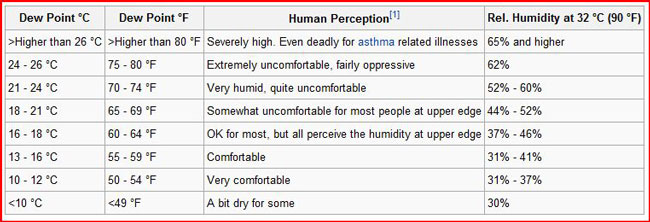Dew point and relative humidity
Dew point and relative humidity are somewhat misunderstood, yet both are very important to our weather! let's review them both. First off, you need to understand that relative humidity means just thatÖ itís the amount of humidity RELATIVE to how much moisture the air can hold! Yup, the air can only hold a certain amount of moisture before it canít hold any more. When it canít hold any more as invisible water vapor, that moisture becomes visible in the form of fog, steam, and clouds. Still with me? OK, Now letís add another wrinkle, air can hold MORE moisture when it is warm than when it is cold.
How does this relate to RELATIVE HUMIDITY and DEWPOINT?
Since air can only hold a certain amount of humidity, the relative humidity tells you how ďfullĒ the air is, compared to how much it can hold. If the RH (relative humidity) is 75%, then you know that the air is currently holding ĺ of the amount it can hold. If it is 100%, then it is holding the maximum amount.
The Dew Point is the temperature at which, if you cool the air, it will get to 100% relative humidity. If a the temperature drops to itís dew point, water will condense out of the air, and outside at night ďdewĒ will form. Since air can hold less moisture as it gets colder, it makes sense that if you cool the air, the RH will go up! So basically, dew points tell you the amount of moisture in the air.
Hereís the interesting part: The Dew Point is a MUCH better measure of how humid the air is than RH. Why? Well, it has to do with that ďwarm air can hold more moisture than cold airĒ thing!
Letís take a cold winter dayÖ itís 25 degrees the dew point is 15Ö.itís so dry that after walking across the rug, you shock yourself with static electricity when flipping the light switch. Even though itís really dry, believe it or not, the relative humidity is at a whopping 65 percent! Why? Because cold air canít HOLD very much moisture! So even though itís capacity for holding moisture is over half full, it still isnít holding very much! However, notice the dew point of only 15? That tells you that thereís not very much moisture in the air and is much more telling that that 65% relative humidity reading!
In contrast, now letís take a hot and humid summer day where the temperature is 93 degrees.. you can picture it right? Letís say the dew point is a VERY STICKY 67 (much higher than that 15 reading above) Well, even though 93 degrees with a dew point of 67 would be a VERY hot and humid day, the relative humidity would only be 42%, because the air is warmer and can HOLD more moisture! Thatís why the Dew Point comes in handy, because a relative humidity of 42% sounds like NOTHING at all... so as we just learned, a relative humidity of 65% in the winter can be bone dry, while a relative humidity of 43% in summertime can be dripping wet! THAT'S why meteorologists look at the dew point instead of relative humidity in regards to comfort levels!
As a general rule of thumb, in the summertime, if you have a dew point of 60 to 65 that is considered a bit humid, and over 65 is considered very humid, 70 or above is considered tropical humid!
Thanks to WMUR Channel 9 in New Hampshire for the explanation.


Thanks to Wikipedia for the Dew Point graphic.











